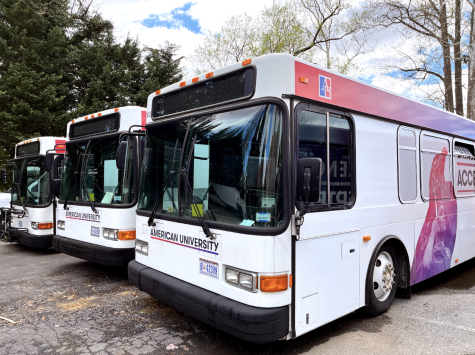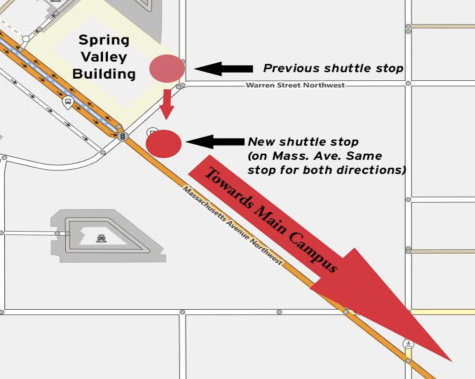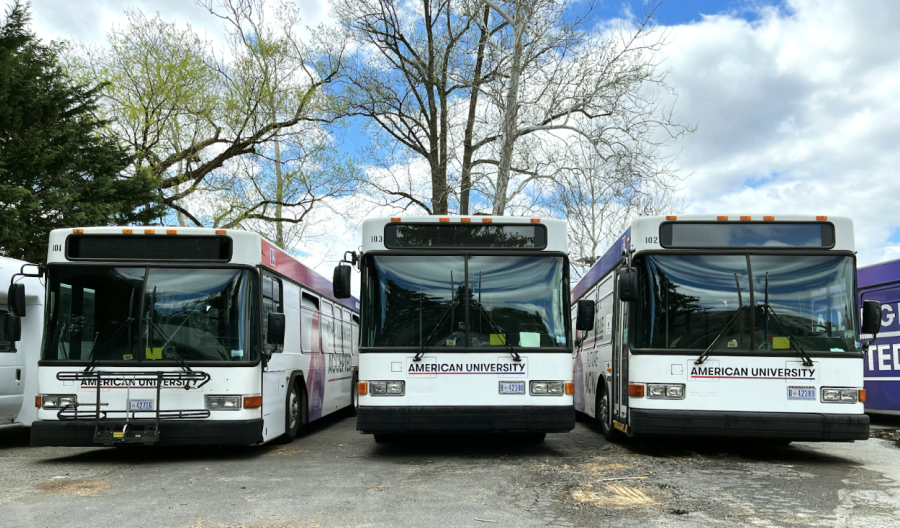Is the AU shuttle in need of change?
Students detail issues with the American University shuttle system relating to accessibility, timing and the mask mandate
Every month, over 10,000 students, faculty and community members use American University’s shuttle system. However, some students have reported issues of accessibility, masking and fluctuating reliability on the shuttle tracking app TransLoc.
According to the Transportation Demand Management letter submitted annually by AU, between August and December of 2021, the shuttle transported almost half a million passengers.
Those on campus go to one of the various shuttle stops either on the main campus, Spring Valley or Tenleytown to get a ride to their destination.
“Monday through Friday the three buses [do] an average of 120 trips between campus and metro. [On weekends], two buses, we make about 79 trips,” said Alef Worku, manager of Transportation Operations and Maintenance for Facilities Management at AU.
Katherine Greenstein, president of the Disabled Student Union, said that there is a lack of accessibility when students enter the AU shuttle.
“If I am traveling with one of my friends, for example, who is a wheelchair user,” Greenstein said. “It can be such a pain in the butt.”
They said that students often run to the doors and look for a seat and are often unaware of other people who may need to board early.
“They don’t realize that the bus driver needs to put down the ramp for one of my friends who uses a wheelchair and they will run in front of them, which is disrespectful and inconvenient,” they said.
Accessible transportation services are provided by the Department of Transportation through DC Circulator and different programs under the Department of For-Hire Vehicles, Matthew McCollough, director of the Office of Disability Rights, said in a statement sent to AWOL.
“These services are in compliance with § 38.23, Mobility Aid Accessibility of the Americans with Disabilities Act (ADA). All buses are equipped with required accessibility features to include kneel or lower capability and equipped with lowered floor ramps or lifts, two wheelchair securement areas with tie-downs and alert buttons, and automated stop announcements,” McCollough said.
The Federal Motor Carrier Safety Administration lays out the Americans with Disability Act requirements for an accessible bus.
“An accessible bus or accessible [over-the-road-bus] is a bus that includes a lift for getting passengers who cannot climb steps onto the bus, specific locations for securing the wheelchair to prevent it from sliding, and other features to ease travel for passengers with disabilities,” the website reads.

In an article posted on April 8 by the Eagle, students reported filing a suit under the Americans with Disabilities Act about the inaccessibility of the shuttle system.
Senior Fiona Murphey uses a wheelchair and said that she had been put in dangerous situations on the shuttles.
“It is an issue with the drivers not being trained in how to operate the equipment that secures wheelchairs to the floor of the bus,” Murphey said.
She said that she had experiences in which bus drivers either refuse to lock her in or lock her in improperly, causing her to move around when the bus takes turns.
“They would get angry with me and then either refuse to do it or do it incorrectly,” Murphey said. “That is like being asked to get into a car with no seatbelt and sit in the driver’s seat in terms of danger levels.”
Murphey said that the driver would lower the ramp, she or a friend would push her up the ramp. Then, the driver would fold the seats up where the wheelchair securing equipment is, and lock her in.
“I gather that there are new drivers periodically, or if someone cannot make it, it was clear one way or another that not all drivers have been trained in how to use the equipment,” she said.
Murphey said she wants the university to make sure drivers are regularly trained in using the equipment.
Worku said the bus drivers have trained on the wheelchair securing system with training materials, such as videos and instruction manuals from the manufacturer. He also said that new drivers are trained during orientation and as needed to maintain proficiency by their supervisors.
“In a short distance trip and due to reduced speed limit on the routes, the Department of Transportation Americans with Disabilities Act [regulations] dictates that we can allow wheelchairs to ride unsecured,” Worku said. “If the rider chooses for a wheelchair to be secured, drivers provide requested assistance.”
According to the Federal Transit Authority, transit operators can adopt a policy that allows wheelchair users to ride unsecured. However, if a user wishes for their wheelchair to be locked, then the operator must lock it.
Service animals are allowed on the shuttles and no one can be denied service for having a service animal, Worku said. According to the Federal Transit Administration website, “transit entities are only required to allow service animals to accompany individuals with disabilities in vehicles and facilities.”
Ben Shore, a member of DSU, was denied boarding the shuttle with his service dog, Charlie. Shore alerted the shuttle driver that his dog was a service animal for diabetes. The driver refused to let him on, and he had to walk a mile and a half to campus. After this experience, Shore said he was not surprised it happened as this is a common theme at AU for him.
“I don’t feel like American University really cares that much about their disabled students. I am really hurt and I really wish the school would take action,” he said.
After emailing AU’s Title IX office five times to report the experience, Shore was left with no response.
“So rather than respond to me, they just kind of ignored me and pretended like it never happened,” Shore said.
Students have also reported concerns about mask usage on the university shuttles.
The AU mask mandate was lifted on March 21 and then reinstated on April 11 after a rise in COVID-19 cases. Shuttle riders must wear their masks properly on the shuttle from the time they step on to the time they step off.
Full-time shuttle driver Kefala Kelly said riders on shuttles have a tendency to forget to wear a mask when traveling.
“Sometimes there are people asking me if I have masks,” Kelly said. “We do not have all that. Sometimes I don’t know how to deal with that kind of thing because in some [cases] they just get in and some of them they just use their jacket and that is definitely a problem.”
Worku said almost all riders wear face coverings. Only on the rarest occasion do drivers need to remind riders to wear them properly, he said.
Kelly said that he wishes the university would do more to assist the drivers in maintaining the mask mandate on shuttles, such as putting masks on the shuttle for the drivers to hand out.
Students have also reported inconsistencies with the shuttle timing. An Eagle article from 2017 describes the riders of the shuttle system waiting upwards of 25 minutes between rides.
The headway time for the shuttle system is recorded when a rider is standing at Kogod, specifically measuring the time between when the first bus leaves and the next bus comes. Worku said that the average headway time, recorded in March in the morning, was 6.5 minutes.
Sophomore Abigail Lynn Williams, a student who lives in Frequency, AU’s off-campus apartment-style residence hall, describes waiting for buses longer than anticipated at night.
“I’ve been standing in the cold for almost 40 minutes waiting for the shuttle to come to go home,” Williams said. “And it is late and I do not want to walk because it is dark.”
Vincent Harkins, assistant vice president of the Facilities Management Office of Finance & Treasurer, sent an email on March 28 alerting the university about a change in the shuttle stop in Spring Valley. On April 4, AU moved the Spring Valley bus stop to the main road instead of on the side of the Spring Valley Building.

“Now, instead of stopping once and staying there,” said Ellie Ralph, president of East Campus. “It stops once for like a minute and then has to go all the way around the circle and does not stop on the other side.”
This causes delays of up to 25 minutes, Ralph said.
“[The shuttle] drops off at the normal time that it would, but it does not wait for classes to get out to pick those students up,” she said.
The TransLoc app is used to track shuttle locations as well as arrivals and departures. However, students report difficulties with the app.
“If I am being honest, the different times on it are never accurate, but I like being able to track where the bus is,” said Ralph, who checks the app every morning before going to her classes.
Worku said he has spoken with TransLoc management to discuss potential fixes.
“We’ve gotten feedback from as far as the app from the students, faculty and staff. We’ve been working closely with them. They made some modifications. And I think it’s the latest version that they have, actually, about a week [ago],” said Worku.
Though the shuttles can be improved, Kelly enjoys driving the shuttles. Kelly said that his favorite part of the day is when students thank him for driving them.
Kelly said that seeing students happy, smiling and thanking him makes his job even more special. He takes this thank you as a sign he is doing a good job and riders are enjoying the shuttle.
Kelly said that bus drivers like himself always want to hear feedback from riders to improve their service.
“We just like to listen from you guys. For me, when I see the students, they always saying thank you and appreciate us. That is proof for me that we are doing good service,” Kelly said.
Kelly said that he does not know how the system is working for students unless they talk to him about it.
“The system for me looks like it is working, but unless you guys tell us, it is hard to understand how the service is [going],” he said.
Alef Worku, Transportation Manager, wants all possible feedback about the shuttles. If you have any feedback or suggestions, please email [email protected] with your feedback.
Helena Milburn contributed to reporting for this story.

Kathryn Gilroy (she/her) is a double major in Broadcast Journalism and Legal studies planning to graduate in 2024. She is interested in becoming a news...









